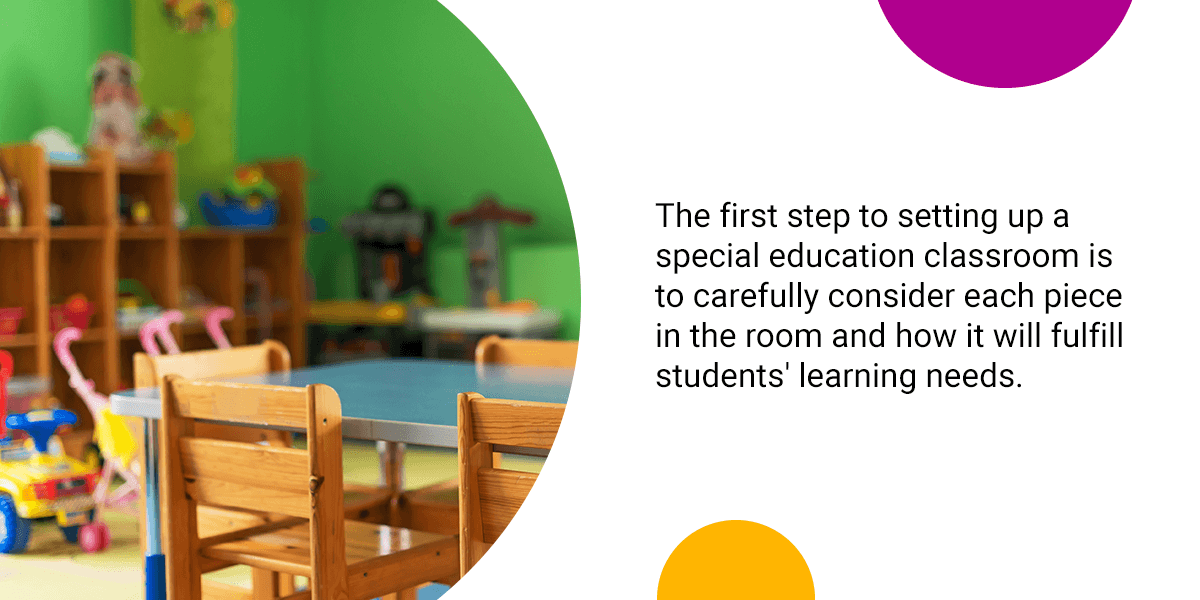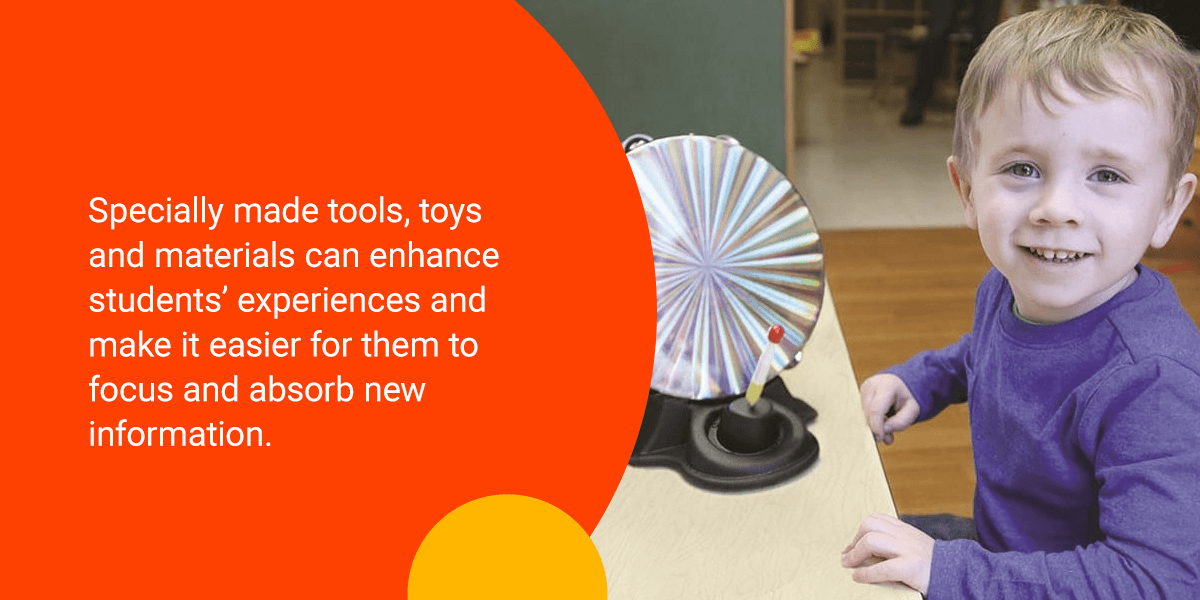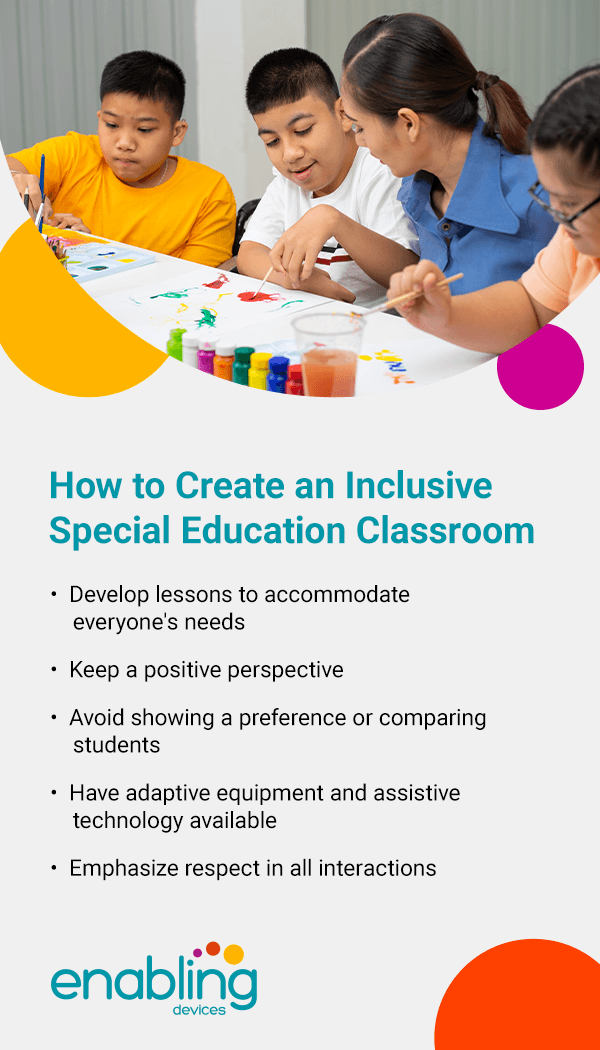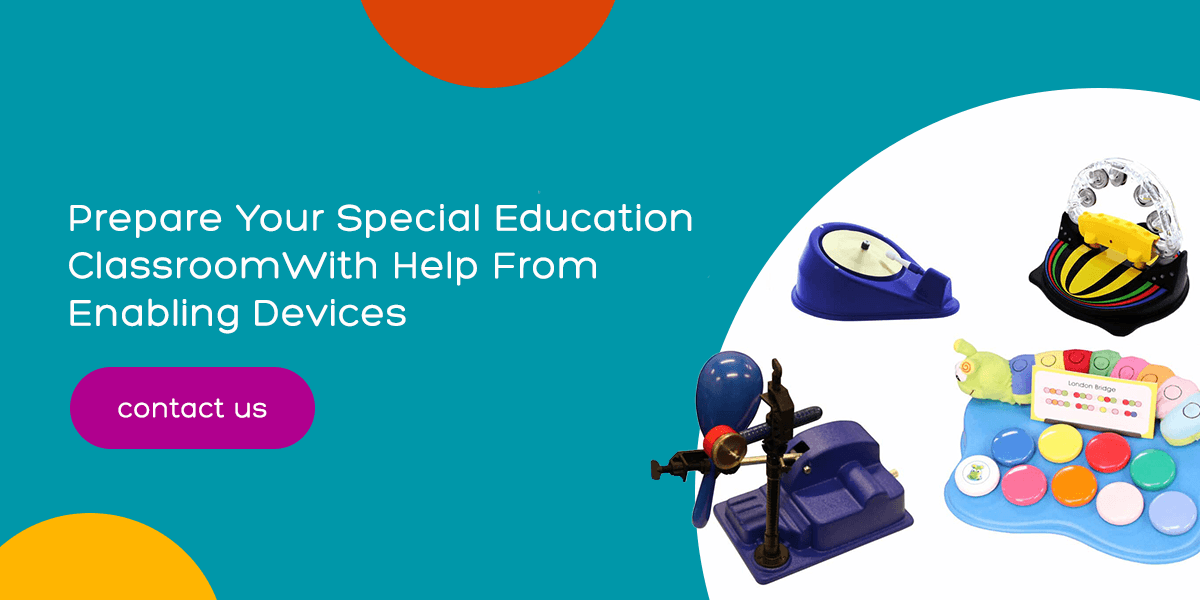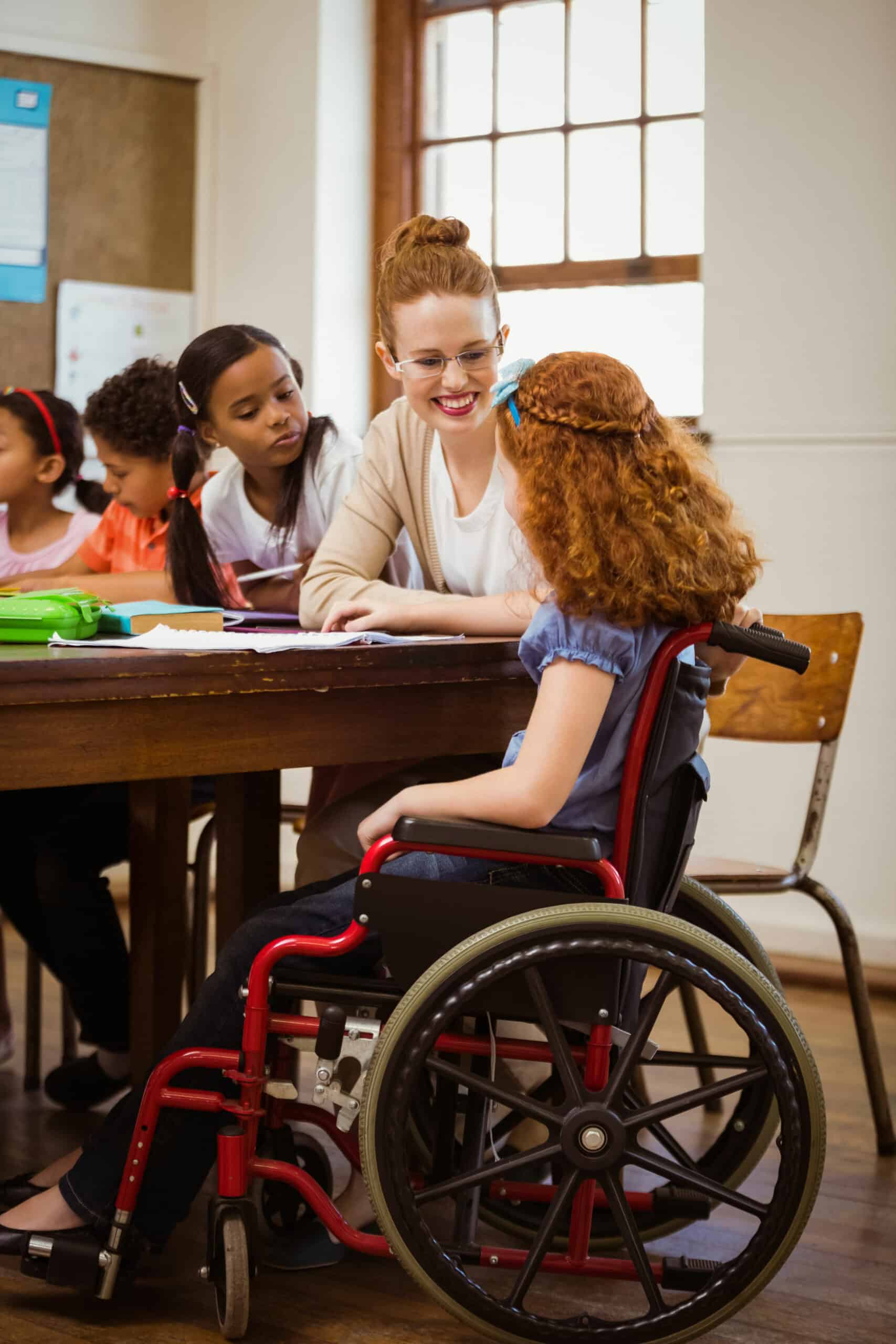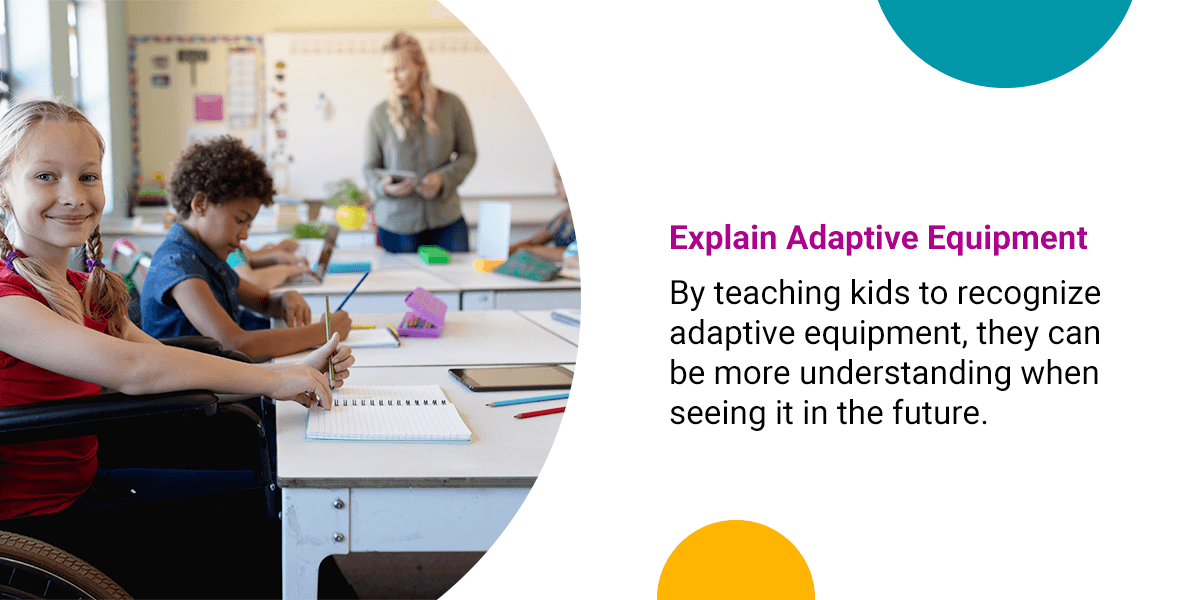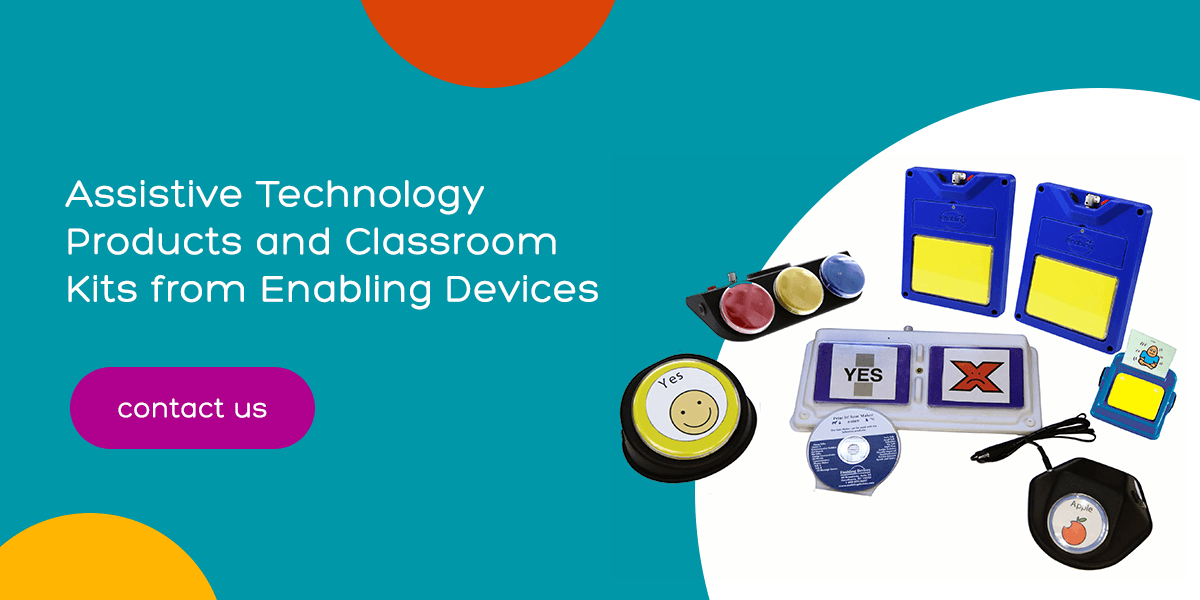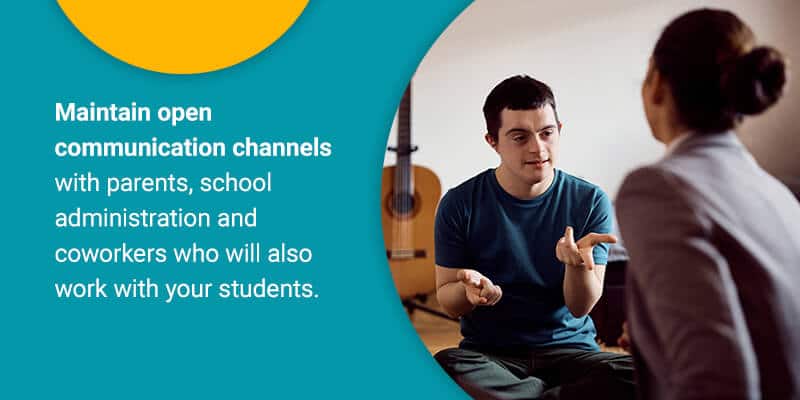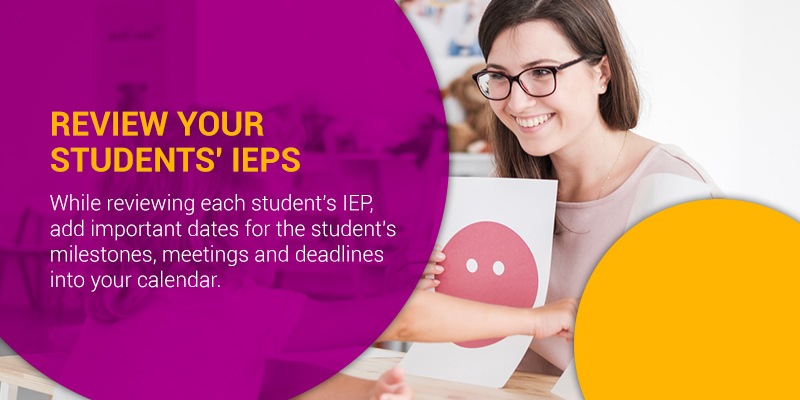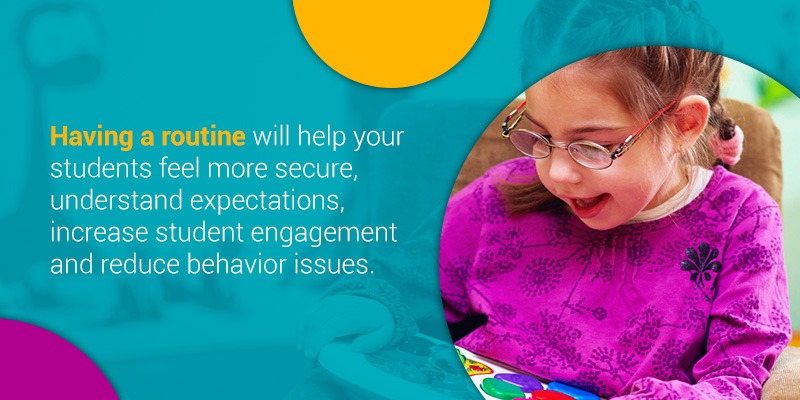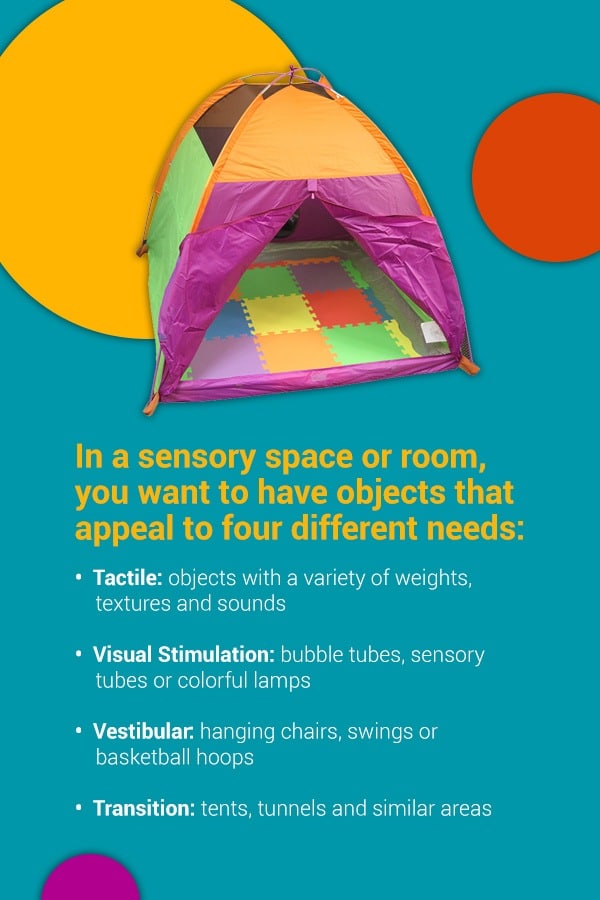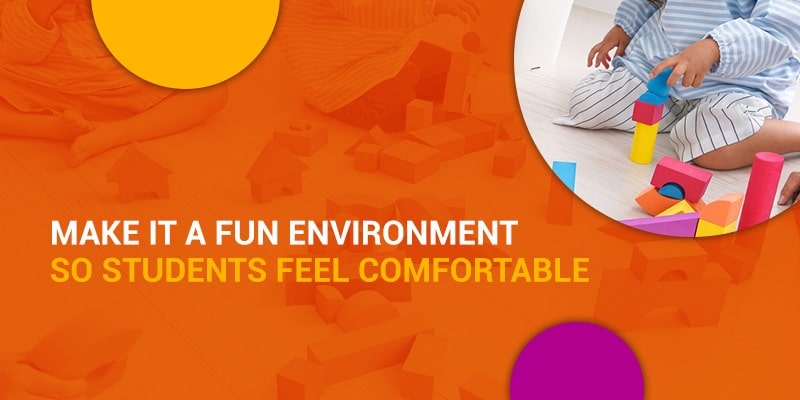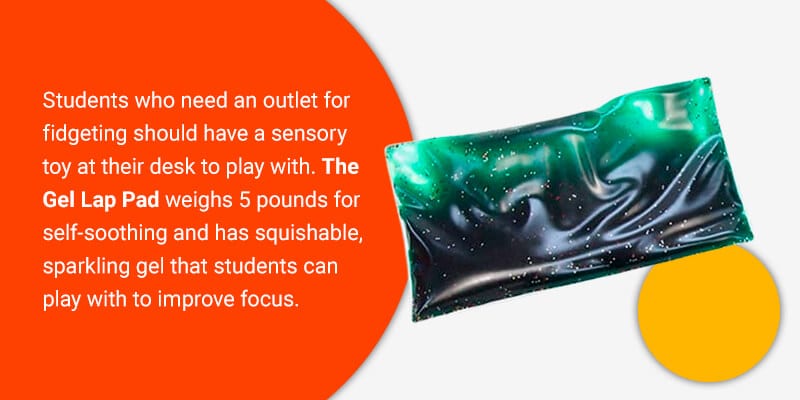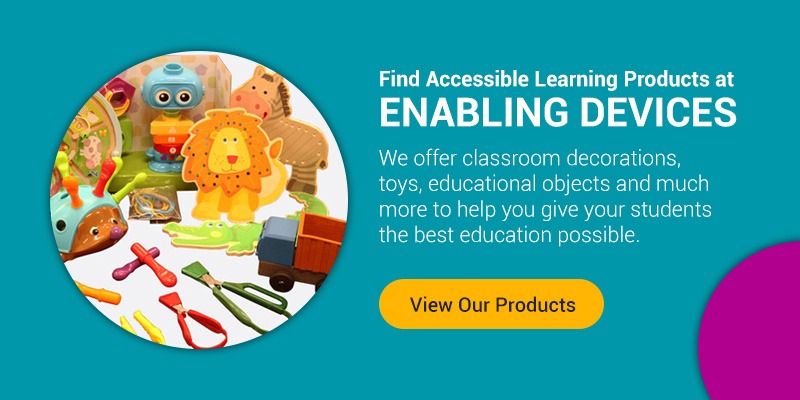As a special education teacher, it’s important to set up your classroom with the right equipment that caters to a wide range of your students’ needs and abilities. Special education teaching materials include tools, devices, equipment and products that enable your students to improve their sensory skills and develop essential fine motor functions like grasping, pressing buttons and using writing utensils.
Whether you’re setting up a new or existing classroom for children with functional needs (commonly referred to as special needs), the possibilities are endless! Enabling Devices offers everything you need with the highest quality, most innovative adapted toys, electronics and communication devices. Explore special education classroom must-haves that can help enable learning, play, communication and independence for students with disabilities.
1. Special Education Classroom Toys
Learning about cause and effect — the relationship between one action, behavior or event to another — is crucial for understanding how things work and navigating the world outside the classroom. Toys that teach cause and effect help children to develop intentionality and a sense of control over their environments, which in turn increases self-esteem.
Understanding cause and effect also helps children in academic pursuits such as reading, math and science. For children with sensory-motor challenges, toys controlled by capability switches are wonderful vehicles for teaching these skills. Enabling Devices has many adapted tabletop toys that can be used with or without switches.
Here are some of our favorite special education materials for teachers:
- Learn & Dance Zoo Activity Center: This interactive toy features four colorful buttons on the base to activate animal sounds and cute animal friends that play short songs. This toy helps teach cause and effect. By maneuvering, pressing and spinning different elements, students can make the animals speak and dance for an exciting safari experience!
- The Drumbourine: This musical toy activates by a switch, causing a striker to hit the tambourine, play a strong steady beat and produce radiant light graphics. When the student releases the switch, the music will stop, helping them learn how their actions lead to the reward of music.
- The Twirling Bead Chain: When a user presses the bright red gumball switch, the carousel will twirl and play lively music while the lights sparkle. Release the switch and the carousel stops. This toy is great for teaching cause and effect and also encourages reaching and provides auditory and tactile experiences.
- Our ATL Bundle: The ultimate way to outfit your special education classroom and teach students about cause and effect is with a bundle of toys with various shapes, sizes and textures for students to manipulate and interact with. Our carefully assembled classroom kit contains five of our newest and most popular adapted toys and five of our bestselling switches.
- Old MacDonald’s Farm: Your students will adore this brightly colored musical toy that sings their favorite nursery rhyme. This teaching toy is equipped with four built-in capability switches that activate different animal sounds and the familiar tune that everyone loves.
2. Communication and Circle Time Tools
Circle time provides students with functional needs the opportunity to bond with each other and encourage listening and communicating in various ways. Circle time also helps children develop their social skills by creating a consistent routine of daily, structured interactions that enhance their sensory-motor skills and language development.
This activity prepares children to learn respect for others’ opinions and build a sense of community and belonging. Over time, your students will strengthen their social competencies as they come together for a shared experience. Using special education materials and devices, children can more effectively and confidently communicate with you and other students regardless of their needs and abilities.
Enabling Devices develops communication devices and adapts many toys that are ideal for facilitating these skills during circle time. Explore these communication tools for special education teachers to enhance students’ experiences with circle time:
- Big Talk Triple Play: Our sequential communicator allows a child to be the day’s leader during circle time. Multiple recordable messages enable the student to introduce the day and date, review the weather and say good morning to everyone in the circle. This communicator is great for encouraging children with speech impairment to participate in classroom activities.
- Lighted Vibrating Mirror: Children love to take turns looking at themselves and then passing this multisensory mirror around the circle. Designed with two handles so it’s easy to grasp, the mirror offers visual and tactile stimulation while helping to encourage grasping and increase hand and finger strength.
- Music Machine: Our Music Machine includes a variety of instruments including cluster bells, castanets, jingle bells and drum sticks. Just attach whatever instrument the class chooses, add a single switch and give each child an opportunity to make beautiful music during circle time. This toy is great for developing auditory skills and teaching cause and effect as well as music appreciation. It’s also ideal for children who cannot grasp instruments on their own for long periods of time.
- Ring Around Bells: Let each child in the circle take a turn making this switch-activated toy’s colorful, precision-tuned bells twirl and play the musical scale while its multicolored LEDs blink. This toy encourages listening and grasping and increases eye-hand coordination, all while teaching children to appreciate music.
- Bongo Drums: When equipped with two capability switches, our Bongo Drums can be played by two children in the circle at once. Pass it around so that every child has the chance to practice sharing, cooperation and listening skills while learning cause and effect and music appreciation.
- Vibrating Animal: Is one child in the circle having a hard day? The Vibrating Animal can help them relax so they can attend to whatever’s being taught during circle time. Alternatively, pass the vibrating plush animal around the circle so that everyone can enjoy the tactile stimulation and calming effect of holding this soft, cuddly friend.
3. Fine Motor Development Tools for Your Classroom
Fine motor skills are small muscle movements in the fingers, thumb and hands that work in coordination with the eyes to perform important tasks such as writing, dressing, eating and toileting. Children with functional needs may need assistance grasping crayons, pressing buttons, using scissors or picking up toys. Fine motor movement improves eye-hand coordination, contributes to physical awareness and assists in the development of communication skills, such as talking, writing, drawing or using touch or switch-enabled devices to communicate.
Helping your students build up their fine motor skills can significantly improve their independence and task performance. Improved fine motor skills can also boost a child’s confidence in their ability to complete daily functions.
Many children with functional needs require extra practice to develop fine motor skills. Fortunately, with the right special education tools and toys on hand, your students can practice and improve their fine motor skills through play and everyday interactions. In fact, the more your students get to play with toys of various shapes and textures, the more attuned their fine motor muscles become.
Enabling Devices designs and adapts many toys and training products that offer fun ways to improve fine motor skills. Here are some of our favorite tools, toys and training products for developing fine motor skills:
- The Pull Ball: Designed like a whiffle ball, the multicolored Pull Ball is perforated with holes that allow a child’s fingers to easily slip in, grasp and pull. The Pull Ball encourages children to practice their finger, hand and wrist movements. Even the gentlest tug activates the toy’s music and lights. Children will be motivated to reach out, grasp and pull again and again.
- Switch-Adapted Tic Tac Toe: This special take on a classic game has LED lights and switches to encourage interaction and teach directionality. It’s ideal for children who have difficulty with fine motor, dexterity or grasping.
- The Five Function Activity Center: Students can learn cause and effect by activating any of this toy’s five functions. Press the bright yellow plate to play its built-in AM/FM radio, the red plate to feel a vibration, the wooden roller to sound a buzzer, a pull ball to turn on the music box, and the orange one to turn on the light. This toy helps develop sensory awareness and improve eye-hand coordination.
- ADL Boards: Activities of daily living (ADL) boards are a must-have for any special education classroom supply list. This product gives students valuable practice with fine motor skills they will need to dress themselves, including lacing, buttoning, zipping and snapping. Strengthening the muscles in their fingers, hands and wrists can also help with many other skills, like grasping and writing.
- Finger Isolation Button: This unique and colorful switch features a recessed button that helps individuals improve their fine motor and finger isolation skills needed to use touchscreen devices and computers.
- Weighted Hand Writing Glove: Students can perform a variety of fine motor and self-help activities with this weighted compression glove that provides proprioceptive input to help strengthen the response in an individual’s joints and muscles.
Explore more toys and training products that improve fine motor skills.
4. Visual Attention and Tracking Toys and Educational Tools
Visual tracking is a child’s ability to move and control their eye movements. The two types of visual tracking are focusing on an object as it moves across the visual field, and efficiently switching focus between two objects.
In the classroom, children will often have to look up at the board for instructions and learning. However, if they struggle with controlling their eye movements, such as left to right, up and down and in a circular motion, it can be difficult for them to focus and stay visually alert. Some individuals may not be able to move their eyes without moving their heads.
These skills are needed for following both moving and stationary objects and are necessary for reading, body awareness, posture and coordination. Children rely on visual tracking to interact with their environment and know where to look. For instance, a student who has a visual impairment may find it difficult to read without skipping lines or have trouble catching a ball during playtime.
While visual tracking is more challenging for students with a visual impairment, the right toys and activities can help them improve their visual tracking and attention. Enabling Devices offers a range of toys and educational tools designed to develop these skills. Here are some of our favorites:
- Penguin Roller Coaster: Children will develop their visual attention and tracking skills by watching this toy’s adorable little penguins climb to the top of the iceberg and “swoosh” down the slide to the bottom. This toy works with a capability switch, which is sold separately.
- Fubbles Fun-Finiti Bubble Machine: Everyone loves bubble play! This visually entrancing toy offers an infinite amount of fun while teaching students about cause and effect. Students can use a capability switch to activate this toy and watch bubbles soar to the sky, improving eye-hand coordination and visual attention and tracking.
- Tube Tracker: The Tube Tracker provides tons of fun while encouraging visual attention and visual tracking and helping develop students’ switch activation skills. Simply hold down the switch and watch the brightly colored balls move upward on a cushion of air. The Tube Tracker includes six colorful ping pong balls.
- Visual Light Experience Kit: Go for the whole shebang! This huge assortment of toys includes everything you need to help students develop their visual perceptual skills, including visual tracking, scanning and attention. This kit contains 13 items of various shapes and sizes, from musical toys to light-up devices that enhance a child’s visual experience. Keep in mind that this kit should not be used with individuals who are prone to seizures.
Find more toys for students with visual impairment on our site.
Get Your Classroom Must-Haves From Enabling Devices Today
As a special education teacher, you are constantly working to ensure your students’ needs are met. One of the most important things you can provide, regardless of a student’s abilities, is the possibility to enable them to do and learn more. At Enabling Devices, it’s our goal to help you make small but meaningful changes to your classroom that allow students to play, grow and learn new skills.
We design and develop tools, toys and products that provide more hands-on learning opportunities so children with disabilities can reach their full potential and feel more confident in their abilities. We offer a wide range of products to help students with functional needs maximize their time in your classroom and meet their individual goals.
Browse our products online to explore toys and devices you can use to enhance your classroom, or contact us today to see if we can create a custom product for your student.







